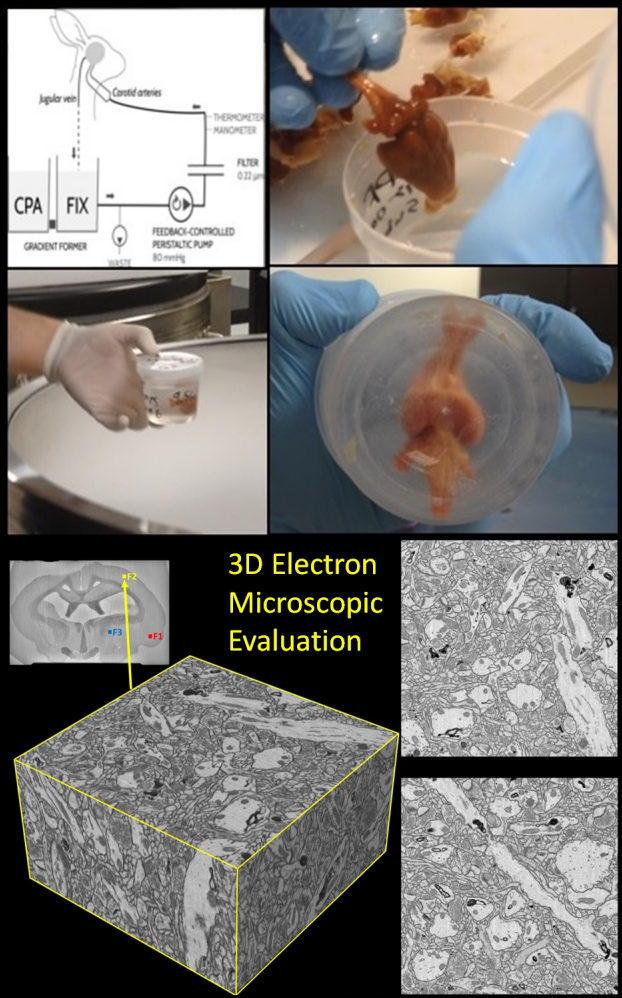Newly invented Aldehyde-Stabilized Cryopreservation procedure wins Brain Preservation Prize
 The Small Mammal Brain Preservation Prize has officially been won by researchers at 21st Century Medicine. Using a combination of ultrafast chemical fixation and cryogenic storage, it is the first demonstration that near perfect, long-term structural preservation of an intact mammalian brain is achievable. You can view images and videos demonstrating the quality of the preservation method for yourself at the evaluation page. This result directly answers what has been a main scientific criticism against cryonics, and sets the stage for renewed interest, research, and debate within the mainstream scientific and medical communities.
The Small Mammal Brain Preservation Prize has officially been won by researchers at 21st Century Medicine. Using a combination of ultrafast chemical fixation and cryogenic storage, it is the first demonstration that near perfect, long-term structural preservation of an intact mammalian brain is achievable. You can view images and videos demonstrating the quality of the preservation method for yourself at the evaluation page. This result directly answers what has been a main scientific criticism against cryonics, and sets the stage for renewed interest, research, and debate within the mainstream scientific and medical communities.
“Every neuron and synapse looks beautifully preserved across the entire brain. Simply amazing given that I held in my hand this very same brain when it was vitrified glassy solid… This is not your father’s cryonics.” – Dr. Kenneth Hayworth, BPF President
The Brain Preservation Foundation’s (BPF) Small Mammal Prize has officially been won. A team from 21st Century Medicine, spearheaded by recent MIT graduate Robert McIntyre, has discovered a way to preserve the delicate neural circuits of an intact rabbit brain for extremely long-term storage using a combination of chemical fixation and cryogenic cooling. Proof of this accomplishment, and the full “Aldehyde Stabilized Cryopreservation” protocol, was recently published in the journal Cryobiology and has been independently verified by the BPF through extensive electron microscopic examination. This answers a challenge issued to the scientific and cryonics communities five years ago by the BPF, and carries an award of $26,735.
Throughout the contest, the 21CM team was in a tight race with Max Planck researcher Shawn Mikula to be the first to meet the prize’s strict requirements. Although the prize will be awarded to 21CM, we wish to emphasize that a mouse brain entry submitted by Dr. Mikula also came extremely close to meeting the prize requirements. Dr. Mikula’s laboratory is attempting to perfect not only brain preservation (using a different method based on chemical fixation and plastic embedding) but whole brain electron microscopic imaging as well.
Focus now shifts to the final Large Mammal phase of the contest which requires an intact pig brain to be preserved with similar fidelity in a manner that could be directly adapted to terminal patients in a hospital setting. The 21st Century Medicine team has recently submitted to the BPF such a preserved pig brain for official evaluation. Lead researcher Robert McIntyre has started Nectome to further develop this method.
Background and significance
Proponents of cryonics have long sought a technique that could put terminal patients into long-term stasis, the goal being a form of medical time travel in which patients are stabilized against decay with the hope of being revived and cured by future technologies. To that end, over the last two decades cryonics researchers have made progress eliminating ice formation using a technology from mainstream cryobiology called vitrification. Vitrification uses high concentrations of cryoprotectants that allow tissue to solidify during cooling without the formation of ice crystals. When optimally applied, vitrification eliminates damage to cell structures caused by ice formation and has been shown compatible with recovery of biological functioning in small slices of isolated brain tissue. But when applied to whole brains, limitations in diffusibility lead to dramatic shrinkage of the brain’s tissue. Electron microscope images of such brains show dramatic distortions to the delicate neural circuits, and recovery of biological function in whole brains or animals remains far out of reach.
Such difficulties have led a new generation of researchers to focus on a more achievable and demonstrable goal –preservation of brain structure only, without concern for later biological viability. They focus on demonstrating preservation of the delicate pattern of synaptic connections (the “connectome”) which neuroscience contends encodes a person’s memory and identity. Instead of biological revival, these new researchers often envision a future “synthetic revival” comprising nanometer-scale scanning of the preserved brain to serve as the basis for mind uploading.
This shift in focus toward “synthetic” revival opens up new avenues of research and brings the idea of cryonics squarely within the purview of today’s scientific investigation. Hundreds of neuroscience papers have detailed how memory and personality are encoded structurally in synaptic connections, and recent advances in connectome imaging and brain simulation can be seen as a preview of the synthetic revival technologies to come. Until now, the crucial unanswered questions were “How well does cryonics preserve the brain’s connectome?” and “Are there alternatives/modifications to cryonics that might preserve the connectome better and in a manner that could be demonstrated today?” The Brain Preservation Prize was put forward in 2010 to spur research that could definitively answer these questions. Now, five years later, these questions have been answered: As described above, traditional cryonics procedures have not yet been able to demonstrate (to the BPF’s satisfaction) preservation of the connectome, but the newly perfected “Aldehyde-Stabilized Cryopreservation” technique has.
The key breakthrough was the quick perfusion of a deadly chemical fixative (glutaraldehyde) through the brain’s vascular system, rapidly stopping metabolic decay and fixing proteins in place by covalent crosslinks. This stabilized the tissue and, along with other chemicals, enabled cryoprotectants to be perfused at an optimal temperature and rate for the prevention of brain shrinkage. The result was an intact rabbit brain uniformly filled with such a high concentration of cryoprotectants that it could be vitrified solid and stored at -135 degrees Celsius. Electron microscope images from across the rabbit brain showed beautifully preserved neural circuits which look identical to fixation-only control brains.
This result directly answers a main skeptical and scientific criticism against cryonics –that it does not provably preserve the delicate synaptic circuitry of the brain. As such, this research sets the stage for renewed interest within the scientific community, and offers a potential challenge to medical researchers to develop a human surgical procedure based on these successful animal experiments.
Frequently Asked Questions
What is the Brain Preservation Foundation?
The Brain Preservation Foundation is a non-profit charity with the goal of promoting scientific research and services development in the field of whole brain preservation for long-term static storage.
We incentivize the development of brain preservation technology by offering the large and small mammal brain preservation prizes, with a total prize purse value of $106,940, to the first team that can demonstrate brain preservation according to our strict criteria of synaptic preservation.
We serve the important scientific role of holding any purported brain preservation technology to strict standards of evidence and peer review. Our prize has been mentioned in the New York Times and Scientific American.
Volunteers and advisors for the Brain Preservation Foundation include a host of experts in neuroscience, computer science, philosophy, cryobiology, medicine, and microscopy.
What is the small mammal brain preservation prize?
The challenge of the small mammal prize is to preserve a mouse brain or similarly-sized mammalian brain so that all the neurons and synapses are intact and visible under an electron microscope. Scientists have been preserving small samples of brain tissue at this level of detail since the 1960s, but until now no one has managed to achieve preservation of an entire brain.
Why is this prize important?
Whole brain preservation is a necessary technology for detailed study of the whole brain’s microscopic anatomy, and is a necessary tool to help us tackle the great challenge of understanding how the brain works. An understanding of the brain’s complete wiring will greatly help our understanding of diseases such as Alzheimer’s — and how we might treat them. Even more importantly, there is compelling preliminary evidence from the neuroscience literature that preserving a brain at the ultrastructure level (the level of detail required to win our prize) might also preserve the memories stored in that brain. Now that whole brain preservation is a scientific reality (at least for rabbits), we look forward to a lively scientific debate over the exact level of preservation necessary to preserve memory.
We see this prize as an important prerequisite milestone towards the development of a robust memory preservation protocol for humans.
What is the history of the prize?
The Brain Preservation Foundation was founded in May 2009 with the goal of furthering research in whole brain preservation. In May 2010, after a donation of $100,000 from serial entrepreneur and technologist, Saar Wilf, we began offering the large and small mammal brain preservation prizes for the first team that could meet our stringent brain preservation criteria.
By 2012 two teams had stepped up to the challenge: Shawn Mikula at the Winfred Denk lab in Germany was using plastic embedding to preserve mouse brains, while Greg Fahy at 21st Century Medicine (21CM) was using cryobiological techniques to preserve brains using extreme cold.
By 2015, both teams were still having problems with their techniques which prevented them from winning the prize. Robert McIntyre, a recent MIT graduate and brain preservation enthusiast, joined 21CM to pursue research on aldehyde-stabilized cryopreservation (ASC) a hybrid method which combined elements of chemical stabilization from Dr. Mikula’s techniques with cryoprotection and long-term storage methods from 21CM’s efforts.
How did the small-mammal competition end?
After some early promising results with ASC, in September 2015 Dr. Hayworth visited 21CM to witness the ASC procedure and collect samples from two rabbits and two pigs which had been preserved — the first official entry of ASC into the competition. Dr. Mikula also submitted a plastic embedded mouse brain at the same time as the ASC submission, leading to a tense head-to-head competition for the small mammal prize.
After an initial evaluation of both entries, Dr. Hayworth found damage in the core of Dr. Mikula’s plastic embedded brain and the entry was disqualified. Initial results for the ASC rabbit brain looked good, and Dr. Hayworth began an in-depth evaluation to determine the state of the brain’s synapses: He extensively imaged hundreds of brain regions using traditional electron microscopy, and employed comprehensive 3D FIB-SEM imaging on three selected regions. This in-depth evaluation was conducted over four months, until Dr. Hayworth and the rest of the BPF prize judging panel were satisfied.
Now in February 2016, the BPF’s panel of judges has determined that the rabbit brain preserved with aldehyde-stabilized cryopreservation from 21st Century Medicine meets the quality level demanded by the prize, and we finally have a winner of the small mammal prize!
What’s next for the BPF?
Now that the small mammal prize has been won, we will focus our efforts on administering the large mammal prize. It is possible that 21CM’s pig brains are already preserved well enough to win the prize; further evaluation is necessary.
Because whole brain preservation at the synaptic level is now a reality (at least for rabbits), we are very interested in continuing the discussion in the neuroscience community as to what level of memory preservation we can reasonably expect from brain preservation techniques like ASC. Our ultimate goal is to encourage the development of a brain preservation technique which could be applied to humans and which is shown to preserve memory. We’ll do whatever we can to encourage technological development in this direction.
What’s next for the competitors?
Dr. Mikula is working on imaging an entire mouse brain with electron microscopy — a massive multi-year endeavor which promises to be a major step forward in connectomics research. He may also work on adapting his plastic embedding technique to work on large mammals and attempt to win the large mammal prize.
21CM is returning to their research on reversible brain cryopreservation. If they succeed at reversibly preserving a brain, it will be unquestionable that we have a brain preservation technique which preserves memory.
Robert McIntyre has left 21CM and started his own company, Nectome, devoted to advancing the science of brain preservation. He plans to further develop ASC with the goal of creating a memory preservation technology that could work on a human brain.
We are excited to see what the future holds for brain preservation research!





